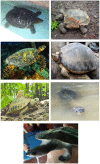Turtles in Malaysia: A Review of Conservation Status and a Call for Research
- PMID: 36077905
- PMCID: PMC9454601
- DOI: 10.3390/ani12172184
Turtles in Malaysia: A Review of Conservation Status and a Call for Research
Abstract
Approximately 356 species of turtles inhabit saltwater and freshwater habitats globally, except in Antarctica. Twenty-four species of turtles have been reported in Malaysia, four of which are sea turtles. The state of Terengganu harbored the highest number of turtles, with 17 different reported species. Based on the IUCN Red List, 29% of turtle species in Malaysia are critically endangered. In comparison, another 25% are classified as endangered. Likewise, CITES reported that 67% of Malaysia's turtles are threatened, while 25% are classified as critically endangered. This review discusses the checklists, molecular genetics work, conservation status, recent trends, and recommendations for future research. Factors contributing to their population declines and current endangered status are also discussed.
Keywords: CITES; IUCN Red List; checklist; endangered; genetic; sea turtles; taxonomic.
Conflict of interest statement
The authors declare no conflict of interest.
Figures





Similar articles
-
Coastal lagoons in the United Arab Emirates serve as critical habitats for globally threatened marine megafauna.Mar Pollut Bull. 2024 Mar;200:116117. doi: 10.1016/j.marpolbul.2024.116117. Epub 2024 Feb 15. Mar Pollut Bull. 2024. PMID: 38364638
-
Salinity tolerances and use of saline environments by freshwater turtles: implications of sea level rise.Biol Rev Camb Philos Soc. 2018 Aug;93(3):1634-1648. doi: 10.1111/brv.12410. Epub 2018 Mar 25. Biol Rev Camb Philos Soc. 2018. PMID: 29575680 Review.
-
Disease risk analysis in sea turtles: A baseline study to inform conservation efforts.PLoS One. 2020 Oct 23;15(10):e0230760. doi: 10.1371/journal.pone.0230760. eCollection 2020. PLoS One. 2020. PMID: 33095793 Free PMC article.
-
Saving sea turtles: the evolution of the IUCN Marine Turtle Group.Endeavour. 2005 Sep;29(3):114-8. doi: 10.1016/j.endeavour.2005.06.002. Endeavour. 2005. PMID: 16054217
-
Systematic review of reptile reproductive toxicology to inform future research directions on endangered or threatened species, such as sea turtles.Environ Pollut. 2021 Oct 1;286:117470. doi: 10.1016/j.envpol.2021.117470. Epub 2021 Jun 2. Environ Pollut. 2021. PMID: 34438481
Cited by
-
Characterization of the complete mitochondrial genome of the critically endangered Southern River Terrapin, Batagur affinis affinis (Reptilia: Geoemydidae).Mitochondrial DNA B Resour. 2023 Jul 4;8(7):719-722. doi: 10.1080/23802359.2023.2222851. eCollection 2023. Mitochondrial DNA B Resour. 2023. PMID: 37426572 Free PMC article.
-
Global Terrapin Character-Based DNA Barcodes: Assessment of the Mitochondrial COI Gene and Conservation Status Revealed a Putative Cryptic Species.Animals (Basel). 2023 May 23;13(11):1720. doi: 10.3390/ani13111720. Animals (Basel). 2023. PMID: 37889683 Free PMC article.
-
Conservation Genetics of the Critically Endangered Southern River Terrapin (Batagur affinis) in Malaysia: Genetic Diversity and Novel Subspecies Distribution Ranges.Biology (Basel). 2023 Mar 29;12(4):520. doi: 10.3390/biology12040520. Biology (Basel). 2023. PMID: 37106721 Free PMC article.
References
-
- Forero-Medina G., Páez V.P., Garcés-Restrepo M.F., Carr J.L., Giraldo A., Vargas-Ramírez M. Research and conservation priorities for tortoises and freshwater turtles of Colombia. Trop. Conserv. Sci. 2016;9:3708. doi: 10.1177/1940082916673708. - DOI
-
- Lau M.M., Ruqaiyah S., Devadasan A., Duraisingham G.S., Zulkifli R. Report on the Third Technical Consultation on Research for Stock Enhancement of Sea Turtles (Japanese Trust Fund IV Program) World Wildlife Fund; Petaling Jaya, Selangor, Malaysia: 2009. Satellite tracking of Green turtles and Hawksbill turtles in Peninsular Malaysia by WWF-Malaysia; pp. 101–114.
-
- Peters M.E. Master’s Thesis. Utrecht University; Utrecht, The Netherlands: 2018. Identification and taphonomy of a Miocene Leatherback Turtle (Testudines: Dermochelyidae) from the Westerschelde.
-
- Chan E.H. Marine turtles in Malaysia: On the verge of extinction? Aquat. Ecosyst. Health Manag. 2006;9:175–184. doi: 10.1080/14634980600701559. - DOI
-
- Chan E.H., Liew H.C. The Leatherback Turtle-A Malaysian Heritage. Tropical Press Sdn. Bhd.; Kuala Lumpur, Malaysia: 1989.
Publication types
LinkOut - more resources
Full Text Sources
Miscellaneous

